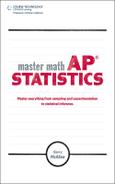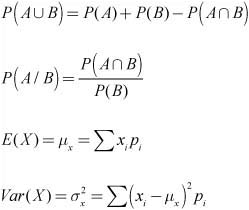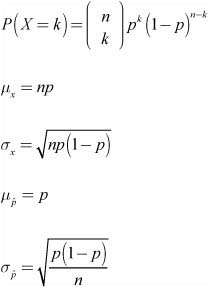Many formulas are given on the AP Statistics Exam. The first section of this appendix provides the formulas that you will be given during the AP Exam. The second section of this appendix is a summary of formulas not given on the AP Exam. You should be familiar with the formulas that will be given on the exam (but there’s no need to memorize them). You will probably not use all of the formulas that are given. In fact, you may never use a few of them in the entire course. You should also know and understand all of the formulas in the second section of this appendix, because those will not be given to you on the exam. Knowing the formulas that will not be on the exam will put you at ease when solving problems and will let you focus on answering the questions and doing so in context. Also notice that some of the formulas given on the exam will help you remember the formulas that are not on the exam.
The following formulas for Descriptive Statistics, Probability, and Inferential Statistics are given on the AP Statistics Exam:
The following formulas are given and should be used if X has a binomial distribution with parameters n and p:
If ![]() is the mean of a random sample of size n from an infinite population with mean μ and standard deviation σ, then:
is the mean of a random sample of size n from an infinite population with mean μ and standard deviation σ, then:
Single-Sample |
|
|---|---|
Statistic | Standard Deviation of Statistic |
Sample mean |
|
Sample proportion |
|
Two-Sample |
|
Difference of sample means |
|
Difference of sample means |
|
(Special case when σ1 = σ2) |
|
Difference of sample proportions |
|
Difference of sample proportion |
|
(Special case when p1 = p2) |
|
Chi-square test statistic |
|
The following formulas are not given on the AP Exam. Be sure to know and understand how they work and how to apply them.
Probability that any two events A and B happen together:
P(A ∩ B) = P(A)
P(B / A)
Notice that this formula is given on the AP Exam, but in the following form:
Probability that two independent events A and B happen together:
P(A ∩ B) = P(A)
P(B)
General addition rule for the union of two events:
P(A ∪ B) = P(A) + P(B) – P(A ∩ B)
Note that ∪ (union) means “or” and ∩ (intersection) means “and.”
If the events A and B are disjoint (mutually exclusive):
P(A ∪ B) = P(A) + P(B)
Rules for means and variances of random variables for fixed numbers a and b:
μz = a ± bμx
σz2 = b2σx2
σz = bσx
Addition rule for variances if X and Y are independent random variables:
σ2X+Y = σ2X + σ2Y
(This is not a typo! We always add variances!)
σ2X−Y = σ2X + σ2Y
Binomial distribution formula:
Notice that the formula for the binomial distribution is given on the AP Exam. It’s given in this section again to ensure that you understand the notation correctly.
Geometric distribution formulas
The probability that the first success is obtained on the nth observation:
P(X = n) = (1 – p)n−1 p
Probability that it takes more than n trials to obtain the first success:
P(X > n) = (1 – p)n
Formulas for the mean and standard deviation of a geometric distribution:
Central limit theorem
The central limit theorem says that as the sample size increases, the mean of the sampling distribution of
approaches a normal distribution with mean, μ, and standard deviation,
Standard error
When using s to estimate σ, the standard deviation of the sampling distribution for means is
When using s to estimate σ, the standard deviation of the sampling distribution is called the standard error of the sample mean,
.
One sample t-interval:
with n−1 degrees of freedom
One sample t-test:
with n−1 degrees of freedom
Two sample t-interval:
The t* value depends on the particular level
of confidence that you want and on the degrees of freedom (df).
Two sample t-test:
Standard deviation of the sampling distribution of
:
When dealing with confidence intervals, we do not know p. Because
is an unbiased estimator of p, we use
to estimate p. These two values should be close in value, provided that the sample is large enough. We can then use the standard error of
:
One-proportion z-interval:
One-proportion z-test:
Note that p0 is the value of the proportion in the null hypothesis.
Two-proportion z-interval:
When dealing with a confidence interval, the values of p1 and p2 are unknown. For this reason, we use the standard error of the statistic
1 −
2 :
Two-proportion z-test:
Use the pooled sample proportion when using a two-proportion test. To find the pooled sample proportion, we use:
Mean of all responses of a linear relationship with x that represents the true regression line:
μ = α + βx
Standard error about the regression line:
or
Confidence interval for the true slope (β) of the regression line:
b ± t*SEb
where SEb is the standard error of the slope. We can find SEb by using the following formula:
![]() You probably will not need to find SEb, as it is typically given on the exam.
You probably will not need to find SEb, as it is typically given on the exam.
Test for the slope β:
where



















